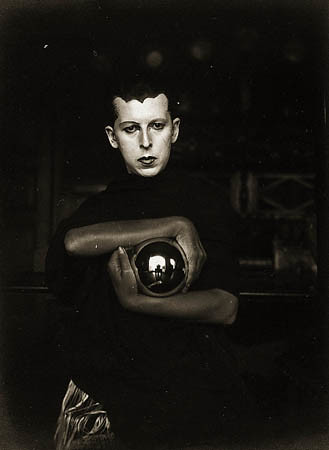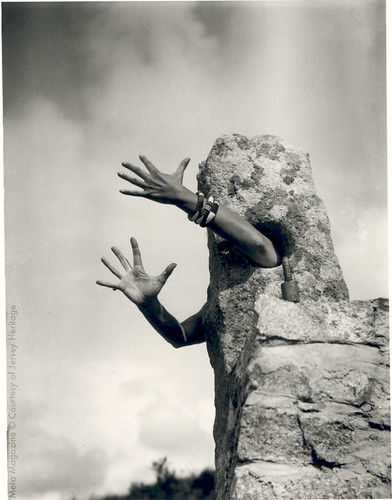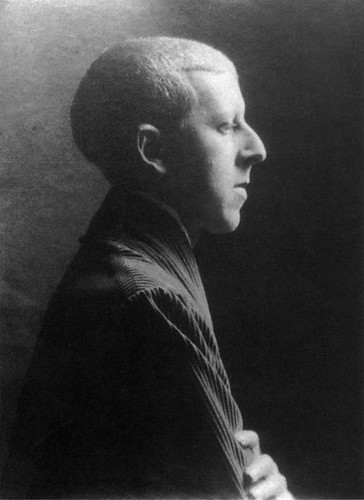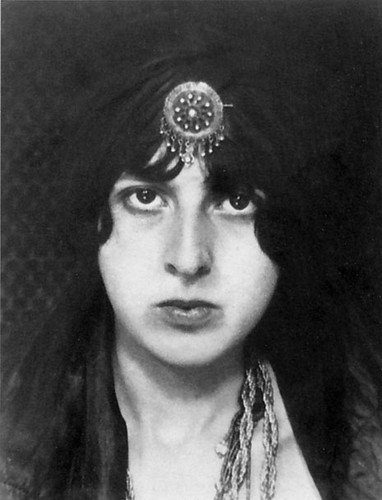Gender Heroes: Claude Cahun (1894-1954)

Claude Cahun, originally uploaded by Peglessness.
Gender Alchymist
by Erica Stratton
While researching a book on Surrealism, a man named François Leperlier came across a remarkable series of self-portraits created by an artist he had never heard of before: Claude Cahun. The name sounded masculine—some early biographers even used male pronouns—but she was female-bodied. In these pictures, Cahun showed a remarkable ability for gender transformation. She holds mysterious props that turn her into a magician, a doll, or an impenetrably masked androgyny. With her hooked nose and a shaved head, it seems she could photograph herself as male, female, or any shade in between.
Though Leperlier rediscovered Cahun in the 1980s—30 years after her death—it wasn’t until the early ’90s that her photos were shown at several international art shows celebrating Surrealism. As scholars delved into Cahun’s work, their perception of her identity seemed to shift with each summation. She collaborated with many of the Surrealists, but didn’t join the movement as one of them; her work is said to be marginalized because she was a woman, but her writing hints that she may not have thought of herself as female. Modern archivists have held her work up as an example of a transperson, an androgyny, a lesbian, queer, and even a transhumanist. She wrote in her autobiography, Disavowals, “Shuffle the cards. Masculine? Feminine? It depends on the situation. Neuter is the only gender that always suits me.”
Cahun was based in Paris throughout most of her career. She wrote and created photographs with her partner, Marcel Moore, until the 1930s, when they retired from the Parisian art world and moved to Jersey Island. They named the house they lived in La Ferme Sans Nom, “the Farm Without a Name,” and lived there until the 1940s. Then, Nazis occupied the island. Cahun and her partner were arrested for putting fliers protesting the occupation under the windshields of Nazi vehicles and inside of newspapers for sale, and leaving cartons full of them in alleyways. They were imprisoned and threatened with execution, but released shortly thereafter.
During her career, Claude Cahun was better known for her writings than her photographs, which were never shown during her lifetime. Happily, Disaovowals and another book, Heroines, have been translated from French into English, but the bulk of her written work still remains uncollected.
I Extend My Arms, uploaded by angeloplessas
Claude Cahun 1920 uploaded by Peglessness
Claude Cahun 1912 uploaded by Peglessness
Category: Gender Heroes 14 comments »








September 10th, 2010 at 8:20 pm |
This was really interesting! I know less than nothing about art or surrealism, but I’m vaguely tempted to find out more, now, just because of this.
[Reply]
September 11th, 2010 at 1:56 am |
How perfectly her work fits into the theme of this blog! In some of the images, a specific gender is clearly implied, while in others there is no implication, and you can take it however you see it. In the first image, before reading the text, I was sure I was looking at an effeminate man. After that, my perceptions flew out the window. An amazing find!
[Reply]
September 11th, 2010 at 2:20 pm |
These photographs are absolutely stunning.
[Reply]
September 12th, 2010 at 4:40 am |
Thankyou!
This was very interesting.
I love the photo of Cahun from the side.
[Reply]
September 12th, 2010 at 7:47 am |
Actually, Cahun and Moore spent ten months on death row in a Nazi military prison on Jersey, released only when the Germans surrendered.They never registered themselves as Jews (as required by an order handed down in Oct. 1940), kept a forbidden radio hidden in an ottoman, and typed out German translations of BBC broadcasts, as well as their own poetry, to give to the soldiers to encourage mutiny.
Their prison notes and letters, and some of their poems, are featured in my historical novel about the occupation, War on the Margins.
[Reply]
Erica (the photo curator) replied:
September 15th, 2010 at 5:41 am
“…kept a forbidden radio hidden in an ottoman, and typed out German translations of BBC broadcasts, as well as their own poetry, to give to the soldiers to encourage mutiny.”
Wow! That makes the story even better. None of the sources I looked at mentioned that.
I’ll be sure to check out War on the Margins. Thanks, Libby!
[Reply]
September 12th, 2010 at 12:13 pm |
L-O-V-E! XO
[Reply]
September 12th, 2010 at 2:25 pm |
wowowow
if claude considered themself “neuter” why does the article use feminine pronouns?
[Reply]
Leigh replied:
September 12th, 2010 at 4:52 pm
Because a lot of people find them difficult and awkward to use?
[Reply]
disapointed replied:
September 14th, 2010 at 2:28 pm
So, “supportive of identities across the gender spectrum” means nothing to you, then?
[Reply]
Erica (the photo curator) replied:
September 15th, 2010 at 6:05 am
Hi Anon, Leigh, Disappointed,
The question of what pronouns to use was something I struggled with a great deal in this article. Despite the above quote, I could not say for certain from the sources I read how Claude identified. There was actually an early draft where I inexpertly used the gender neutral pronoun as an effort to reconcile all the different opinions.
Someone who read this draft responded, “In reading this piece, I am struck by a few things. One is that I am always a little weirded by using language to describe people that they wouldn’t have used themselves – for instance, using a gender neutral pronoun, a relatively recent construction, to describe somebody who lived before such things were really used.” I had some of the same reservations.
Currently, most academic sources refer to Claude using female pronouns, so I compromised by using those for writing clarity and showing examples of how it might not be the full story. I agree that this is an inelegant solution to a complicated problem, and hope that I can come to a better solution for future articles.
September 13th, 2010 at 9:15 am |
Claude is actually one of the very few names in French that can be used for women and men without any change made (the spelling and pronunciations are the same)
[Reply]
September 13th, 2010 at 3:36 pm |
I adore Claude Cahun, thanks for writing this!
[Reply]
October 12th, 2010 at 11:22 pm |
I LOVE CLAUDE CAHUN!
My friend BA got me into Cahun’s photography, and there are so many scenes, incredible scenes, of Cahun’s gender play. One where ze climbs into a cupboard wearing a dress and blond pigtailed wig. One where ze puts hir head into a glass dome and surrounds hirself with smoke.
One thing your article didn’t mention, Cahun and Marcel (who was an accomplished fashion designer) tried to commit suicide while in prison, because they wanted to be able to choose their deaths. Luckily, they were prevented. When Cahun died in the 1950s, Marcel went on for nearly 20 more years before deciding to take her own life.
http://www.squidoo.com/cahun
http://en.wikipedia.org/wiki/Claude_Cahun
http://www.artcyclopedia.com/artists/cahun_claude.html
[Reply]